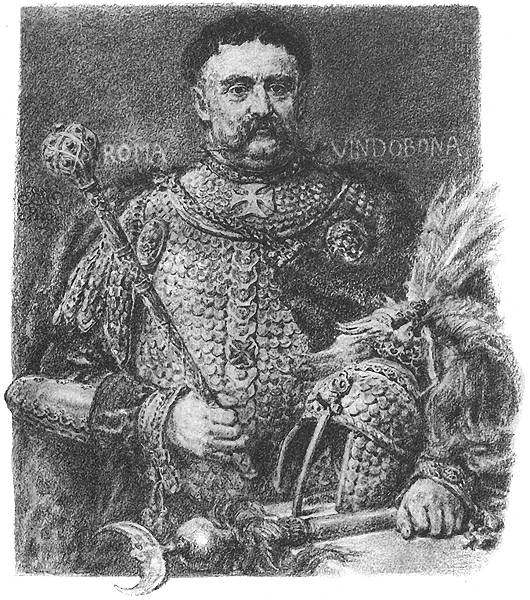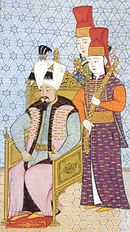
Jan Sobieski.
On September 10, 1683, the papal legate sang a great outdoor mass on the Kahlenberg, west of Vienna, for King Jan III Sobieski and his 16,000 troops. The king of the Polish-Lithuanian Commonwealth had been named commander of the field army of some 85,000 troops, including not only the Polish–Lithuanian contingent, but also troops of the Habsburg Monarchy, Bavaria, Saxony, Franconia, Swabia, the Grand Duchy of Tuscany, and the Zaporozhian Cossacks -- collectively: the Holy League.
Besieging the city were 150,000 troops of the Ottoman Empire, including 70,000 Janissaries led by Grand Vizier Merzifonlu Kara Mustafa Pasha. This was not the first time the Gates of Vienna had been attacked by the world's then-superpower. The first bombardment had been in 1529, and there had been others since; but Vienna still stood. The Sultan had come to uncork the Danube Valley and open the way into Central Europe. Hungary was already his, and the Balkans, and years had been spent planning and organizing this siege.

Below: Jan III Sobieski (left) and Sultan Mehmet IV (right). Note that muslims had no problem depicting human figures in their art. Note also that they weren't into perspective. The Renaissance passed them by.


The Hungarians were Turkish vassals and tried to attack Poland after Jan Sobieski left, but the Lithuanian contingent had been marching behind and defeated them. The Duke of Lorraine defeated another Hungarian force northwest of Vienna, which opened a route for the Bavarians, Saxons, and the other German States. Only Louis XIV of France had refused the Pope's rally call and used the opportunity to seize Hapsburg territories in the Elsass and other parts of southern Germany. (The Elsass (Alsace) would eventually become part of France.) Dead Jannisaries on the field were found to have French money on them; and a French engineer had helped them during the siege.
On September 8, the Turks brought down the Burg bastion and the Löbel bastion, and the Graf von Starhemberg prepared to fight in the streets. But as the relief army crossed the mountains, the Khan of the Crimea failed to block them - some say because he felt snubbed by the pasha. Also in the Turkish army were less-than-enthusiastic vassals George Prince Ducas of Moldavia and Şerban Prince Cantacuzino of Wallachia - essentially: the Romanians. They had tried to warn the West about the impending invasion and had supplied troops only under duress. Some stories contend that the Romanians loaded their cannons with balls of straw so as to not contribute to the siege. (This is a neat trick, but the Romanians pulled it off again in 1945, when they switched to the allied side while still occupied by German armies.)
In the walls of the Griechenbeisl on Fleischmarkt are embedded to this day three Turkish cannonballs. (This is the oldest restaurant in Vienna, and features walls with the scribbled autographs of people who have dined there: Mozart, Beethoven, Mark Twain, etc.)
When the relief armies reached the Kahlenberg, they lit bonfires and the effect on von Starhemberg and the desperate defenders can only be imagined. Perhaps Scott Key spying the banner above Ft. McHenry or the marines on Iwo Jima seeing the flag unroll atop Mt. Suribachi might understand.
The cavalry had come to the rescue.
The Turks hastened to finish a new mine under the Löbel bastion, filled it with gunpowder, and sealed it off. But von Starhemberg detected the mine and the Austrians dug a countermine, and an heroic Hapsburg soldier rushed into the chamber and extinguished the fuse, saving the wall from final breach.
 While Lorraine, Saxony, and Bavaria had been fighting on the left and center, Sobieski had held the cavalry back on the right, on the high ground. When the moment came, he launched downhill the largest cavalry charge in history. It was led by the famous "Winged Hussars" of Poland.
While Lorraine, Saxony, and Bavaria had been fighting on the left and center, Sobieski had held the cavalry back on the right, on the high ground. When the moment came, he launched downhill the largest cavalry charge in history. It was led by the famous "Winged Hussars" of Poland.On September 11-12, 1683, the jihad broke and ran from the Gates of Vienna, leaving 20,000 dead, and all their cannon behind. The Duke of Lorraine was on the left and the German States under the Electors of Saxony and Bavaria in the center. For a first hand account with the usual uncertainties and misspellings, see: Giacomo di Grasse.
After the battle, von Starhemberg emerged from the battered and starving city and kissed Joan Sobieski, calling him his "savior." For his failure, Kara Mustafa Pasha was executed in Belgrade on 25 December by order of the commander of the Janissaries. He was strangled with a silk rope pulled by several men on each end.

The consequences for Europe were incalculable. All one need do is consider that the countries once ruled by Islam remain to this day the poorest in Europe.
After September 11, 1683, no jihadi force attacked on Western land until 2001.
On September 11, just to make their point.


No comments:
Post a Comment